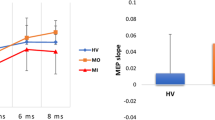Summary
We report a patient suffering from persistent myoclonic jerks in the right forearm without any definite EEG abnormality under routine recording conditions. By computer summation, using the jerk-locked averaging technique, a sharp spike was recognized as a precisely time-locked event in relation to myoclonic twitches. A cranial CT scan revealed a small cortical lesion, which was found very close to the sensorimotor cortex of the right arm. Cerebral blood flow study using the xenon inhalation method revealed a discrete focus of high flow, which corresponded well with the CT lesion. On electrical stimulation of the right median nerve, a large somatosensory evoked potential and an enhanced transcortical long loop reflex were observed. Electrocorticogram showed active focal spike discharges localized at the left precentral gyrus. We postulate that an epileptogenic focus in the motor cortex and an enhanced transcortical long loop reflex appear to be important for the occurrence of epilepsia partialis continua in this patient.
Similar content being viewed by others
References
Burr CW (1915) Continuous clonic spasm of the left arm (Epilepsia continua) caused by a tumor of the brain. Am J Med Sci 149:169–174
Celesia GG (1982) Prognosis in convulsive status epilepticus. In: Delgado-Escueta AV, Wasterlain CG, Treiman DM, Porter RJ (eds) Advances in neurology, vol 34. Status epilepticus. Raven Press, New York pp 55–59
Chatrian GE, Shaw CM, Plum F (1964) Focal periodic slow transients in epilepsia partialis continua. Clinical and pathological correlations in two cases. Electroencephalogr Clin Neurophysiol 16:387–393
Chatrian GE, Shaw CM, Leffman H (1964) The significance of periodic lateralized epileptiform discharges in EEG. An electrographic, clinical and pathological study. Electroencephalogr Clin Neurophysiol 17:177–193
Chauvel P, Louvel J, Lamarche M (1978) Transcortical reflexes and focal motor epilepsy. Electroencephalogr Clin Neurophysiol 45:309–318
Ehrler P (1945) Über epilepsia partialis continua (Kojewnikoff) mit anatomischen Befund. Monatsschr Psychiatr Neurol 110:280–290
Hallett M, Chadwick D, Marsden CD (1979) Cortical reflex myoclonus. Neurology (Minneap) 29:1107–1125
Juul-Jensen P, Denny-Brown D (1966) Epilepsia partialis continua. A clinical, electroencephalographic, and neurophysiological study of nine cases. Arch Neurol 15:563–578
Kelly Jr JJ, Sharbrough FW, Daube JR (1981) A clinical and electrophysiological evaluation of myoclonus. Neurology (NY) 31:581–589
Kugelberg E, Widén L (1954) Epilepsia partialis continua. Electroencephalogr Clin Neurophysiol 6:503–506
Shibasaki H, Kuroiwa Y (1975) Electroencephalographic correlates of myoclonus. Electroencephalogr Clin Neurophysiol 39:455–463
Shibasaki H, Yamashita Y, Kuroiwa Y (1978) Electroencephalographic studies of myoclonus. Myoclonus-related cortical spikes and high amplitude somatosensory evoked potentials. Brain 101:447–460
Spiller WG, Martin E (1909) Epilepsia partialis continua occurring in cerebral syphilis. JAMA 52:1921–1922
Thomas JE, Reagan TJ, Klass DW (1977) Epilepsia partialis continua. A review of 32 cases. Arch Neurol 34:266–275
Töbel F, Schaltenbrand G (1947) Beitrag zur Frage der Lokalisation und Entstehung des Kojewnikoffschen Syndrome (Epilepsia partialis continua). Nervenarzt 18:501–505
Author information
Authors and Affiliations
Rights and permissions
About this article
Cite this article
Kuroiwa, Y., Tohgi, H., Takahashi, A. et al. Epilepsia partialis continua: active cortical spike discharges and high cerebral blood flow in the motor cortex and enhanced transcortical long loop reflex. J Neurol 232, 162–166 (1985). https://doi.org/10.1007/BF00313893
Received:
Accepted:
Issue Date:
DOI: https://doi.org/10.1007/BF00313893




